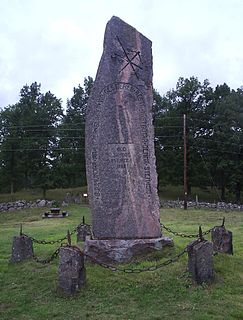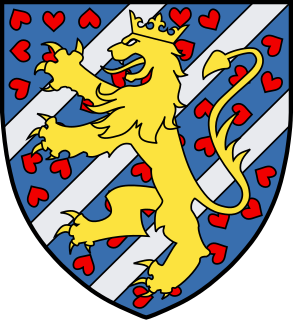
Birger Jarl, or Birger Magnusson, was a Swedish statesman, Jarl of Sweden and a member of the House of Bjelbo, who played a pivotal role in the consolidation of Sweden. Birger also led the Second Swedish Crusade, which established Swedish rule in Finland. Additionally, he is traditionally attributed to have founded the Swedish capital, Stockholm, around 1250. Birger used the Latin title of Dux Sweorum which in English equals Duke of Sweden, and the design of his coronet combined those used by continental European and English dukes.

Swedish pre-history ends around 800 AD, when the Viking Age begins and written sources are available. The Viking Age lasted until the mid-11th century. Scandinavia was formally Christianized by 1100 AD. The period 1050 to 1350—when the Black Death struck Europe—is considered the Older Middle Ages. The Kalmar Union between the Scandinavian countries was established in 1397 and lasted until King Gustav Vasa ended it upon seizing power. The period 1350 to 1523 – when king Gustav Vasa, who led the unification of Sweden, was crowned – is considered the Younger Middle Ages.

Canute II the Tall, was King of Sweden from 1229 until his death in 1234. He was the father of Holmger Knutsson, a later pretender for the Swedish throne. Both father and son were members of the House of Folkung (Folkungar).

Eric "XI" the Lisp and Lame Swedish: Erik Eriksson or Erik läspe och halte; Old Norse: Eiríkr Eiríksson was king of Sweden in 1222–29 and 1234–50. Being the last ruler of the House of Eric, he stood in the shadow of a succession of powerful Jarls, especially his brother-in-law Birger Jarl, whose descendants ruled as kings after his death.

Eric "X" was the King of Sweden between 1208 and 1216. Also known as Eric the Survivor, he was, at his accession to the throne, the only remaining son of King Canute I of Sweden and his queen. The name of his mother is not known, but may have been Cecilia.

Sverker II or Sverker the Younger was King of Sweden from 1195 or 1196 to 1208.

The Battle of the Neva was fought between the Novgorod Republic and Karelians against Swedish, Norwegian, Finnish and Tavastian armies on the Neva River, near the settlement of Ust-Izhora, on 15 July 1240.

The Battle of Gestilren took place on July 17, 1210. The battle was fought between the exiled King of Sweden Sverker and the ruling King Eric X. Sverker had been beaten in the previous Battle of Lena, but returned with new forces. Sverker was however killed in the battle. The exact strength of the armies is unknown.

The House of Bjelbo, also known as the House of Folkung (Folkungaätten), was an Ostrogothian Swedish family that provided several medieval Swedish bishops, jarls and kings. It also provided three kings of Norway, and one king of Denmark in the 14th century.
Magnus Minniskiöld was a medieval Swedish magnate from the House of Bjelbo. For posterity, he is best known as the father of the renowned statesman Birger Jarl, and the ancestor of the later Swedish kings. He is sometimes believed to have perished in the Battle of Lena in 1208, though the evidence is not conclusive.

Gregers Birgersson Greger/Gregory/Gregorius was a Swedish knight, a major landowner and an illegitimate son of Birger Jarl of the House of Bjelbo. He was born out of wedlock by an unknown woman. He was the grandson of Magnus Minnesköld and Ingrid Ylva.
In Sweden, members of medieval royal families, such as the House of Stenkil and House of Bjelbo, held the title of jarl before their accession to the throne. Since the early 12th century, there usually was only one holder of the title at a time, second only to the King of Sweden.

Bishop Benedict, Duke of Finland was a Swedish prelate bishop and duke.
Charles of Tofta, Swedish: Karl Ulfson, Sparre av Tofta was a 14th-century Swedish magnate and High Constable of Sweden.

Charles the Deaf from the House of Bjelbo (Folkungaätten) was the jarl of Sweden during 1216–1220.
Bengt Snivil from the House of Bjelbo was a Swedish magnate in mid-12th century.
Folke the Fat, according to Gesta Danorum by the 12th century Danish chronicler Saxo Grammaticus, was the most powerful man in Sweden around 1100. He married Ingegerd Knutsdotter of Denmark, daughter of the Danish king Canute IV who was murdered in 1086. Folke and Ingrid had the sons Knut and Benedict according to Saxo. The chronicler furthermore reports that Folke was the paternal grandfather of Birger Brosa, who still was alive at the time he wrote.
Karl Magnusson was the Bishop of Linköping during 1216–1220.
Catherine Birgersdotter of Bjelbo was a 13th-century Swedish noblewoman of the House of Bjelbo (Folkungaätten). She was Princess consort of Anhalt-Zerbst.












